Episode 3 of the USLHS podcast “Light Hearted” was originally released on June 10, 2019. In this episode, host Jeremy D’Entremont was joined by co-host Michelle Jewell Shaw. A lighthouse history segment focused on the ancient Roman lighthouse in Dover, England.
The featured interview was with Dolly Bicknell, president of Project Gurnet and Bug Lights, the organization that cares for Plymouth (Gurnet) Lighthouse and Duxbury Pier (Bug) Lighthouse in Massachusetts. Dolly is also the daughter of the famed historian Edward Rowe Snow, and she was the recipient of a “Keeper of the Light” award from the American Lighthouse Foundation. You can listen to the episode with the player below, and the full transcript follows.
JEREMY D’ENTREMONT
You are listening to Light Hearted, the official podcast of the United States Lighthouse Society. My name is Jeremy D’Entremont. We are recording today at the Portsmouth Public Library on the beautiful New Hampshire Seacoast and my cohost today is Michelle Jewell Shaw, who was recently awarded the Len Hadley Volunteerism Award as volunteer of the year for Friends of Portsmouth Harbor Lighthouses at the American Lighthouse Foundation’s annual gala. Congratulations on that and thanks for being with me today, Michelle.
MICHELLE
Hi Jeremy. Thank you for having me here with you on the show.
JEREMY
Well, I really appreciate it. Michelle, I know you’re a photographer and you’ve been photographing lighthouses for a number of years. Maybe you could tell us a little bit more about how you got involved with lighthouses.
MICHELLE
Well, Jeremy, I’ve always loved lighthouses even as a little kid taking annual trips to the Nubble with family in the summertime, but more recently in the past several years as an adult, lighthouses have just become a thing that’s just for me, aside from my family and my kids and just doing things for me and they just represent a lot of peace and happiness for me, so I love to go visit them as often as I can.
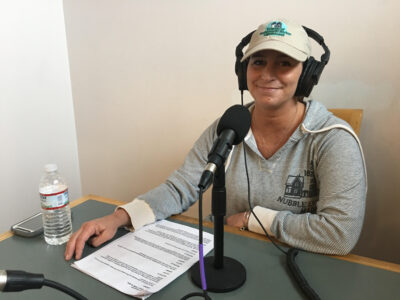
JEREMY
Well, I know we’re very happy to have you as a volunteer for Friends of Portsmouth Harbor Lighthouses and I’m very happy to have you as a part of this podcast as well. So thank you so much Michelle. Now on today’s episode of Light Hearted, we’re going to have some audio, a little bit of audio from an event I recently attended honoring America’s first woman lighthouse keeper, Hannah Thomas. We’re also going to listen to an interview with Dolly Bicknell, president of Project Gurnet and Bug Lights down in southeastern Massachusetts.
MICHELLE
But today we’re going to start with a trivia question first.
JEREMY
[NOTE: THIS CONTEST IS NOW CLOSED.]
Yeah, that’s right. The first two people to email me with the correct answer to the following question will receive prizes. The first gets a 2019 U.S. Lighthouse Society calendar featuring photographs by 14 talented society members. The second gets a lighthouse illumination DVD. The video takes you on an animated tour through the history of lighthouse illumination. Okay, Michelle, what is today’s trivia question?
MICHELLE
People who listened to the last episode of this podcast should know the answer. The question is who wrote the novel The Light at the End of the World, which was the basis for the movie, The Light at the Edge of the World. Again, who wrote the novel The Light at the End of the World, which was the basis for the movie, The Light at the Edge of the World.
JEREMY
Very good. Now I hope people were listening to the last episode. Again, If they listened, they should know the answer to that question. If not, they can cheat and Google The Light at the Edge of the World or The Light at the End of the World,. To enter the trivia contest for this episode, send your answer in an email to me at jeremy@uslhs.org. Again, the email is J E R E M Y at U S L H S dot org. Please be sure to say that you are answering the trivia question in the Light Hearted episode three and include your full name and your mailing address so we can send you your prize if you are a winner.
I recently attended an event on the South Shore of Boston in Kingston, Massachusetts, honoring America’s first woman lighthouse keeper, Hannah Thomas. She served as a keeper at the Plymouth or Gurnet Lighthouse for about a decade beginning in 1776. This past April 13th, close to the 200th anniversary of her death, members of Project Gurnet and Bug Lights, the organization that now takes care of Plymouth Lighthouse, held a ceremony at Hannah Thomas’s grave that included the installation of a bronze U.S. Lighthouse Service marker. The event took place largely through the efforts of Richard Boonisar, a resident of the Gurnet Point section of Plymouth, which is where the lighthouse is, and he’s also the author of a book on the area’s history.
MICHELLE
Much of the event took place inside Kingston’s first parish church. One of the speakers was the only official lighthouse keeper in America today, Sally Snowman of Boston Light. We’re going to play a brief excerpt of Sally’s remarks right now.
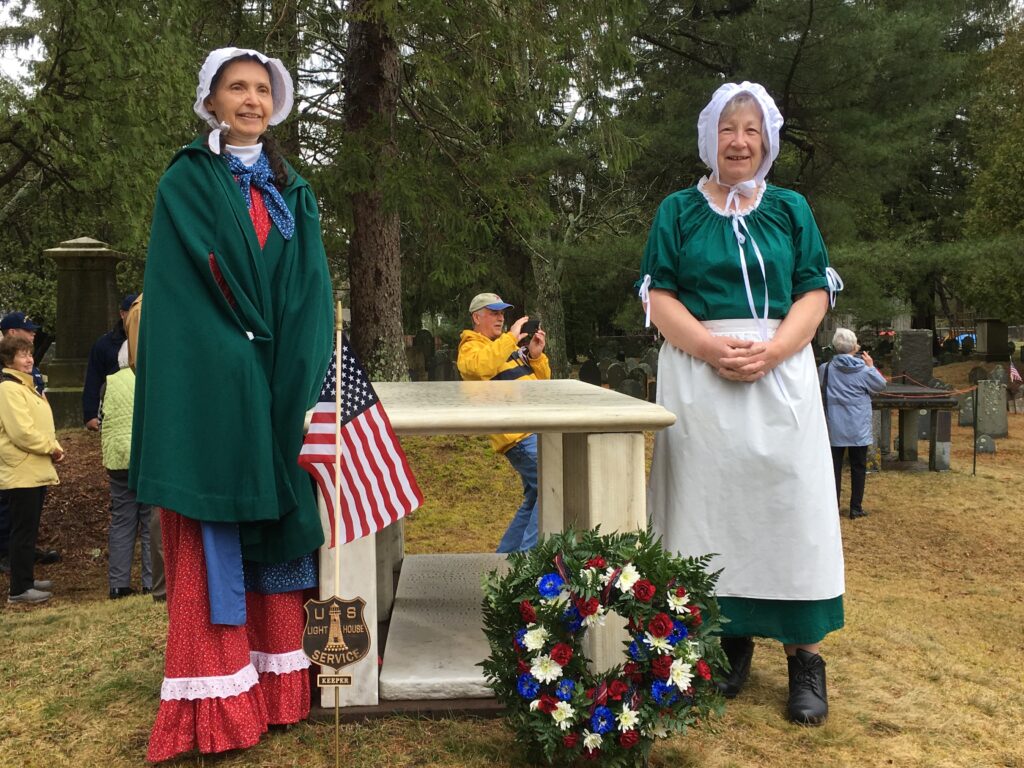
SALLY SNOWMAN
It required an ability to be content with little interaction with humans, integrity to do what needs to be done with what’s available, resolve, courage, tenacity, determination fortitude, humanity – all qualities that Hannah possessed.
MICHELLE
The ceremony moved outside to the cemetery where local Boy Scouts and Girl Scouts helped placed a Lighthouse Service marker and a memorial wreath by Hannah Thomas’s grave.
JEREMY
And presiding over the event honoring Hannah Thomas was Dolly Bicknell, president of Project Gurnet and Bug Lights. Dolly has been a good friend of mine for many years and I had a chance to sit down to interview her following the event on April 13th. Michelle, can you help tell our listeners a little more about Dolly and her organization, Project Gurnet and Bug Lights?
MICHELLE
I sure can, Jeremy. Duxbury Pier Lighthouse in Duxbury, Massachusetts, which is locally known as Bug Light, was the country’s first offshore cast-iron caisson lighthouse when it was built in 1871. It was automated and the keepers were removed in 1964 and the Coast Guard planned to replace it with a fiberglass tower in the 1980s.
JEREMY
Local concerned residents objected, which is a great thing, and Project Bug Light was born and the lighthouse was saved and renovated. Later in 1999, the group was granted a lease on Plymouth Lighthouse, also known as Gurnet Light, and the name of the organization was changed to project Gurnet and Bug Lights.
MICHELLE
Dorothy Snow Bicknell, who’s better known as Dolly to her many friends and family, was born with a love for lighthouses and maritime history in her blood. Her father was the legendary New England historian Edward Rowe Snow, who wrote many books about shipwrecks, pirates, lighthouses, and other nautical lore, and was also famous as the Flying Santa to New England’s lighthouse keepers and their families for more than 40 years.
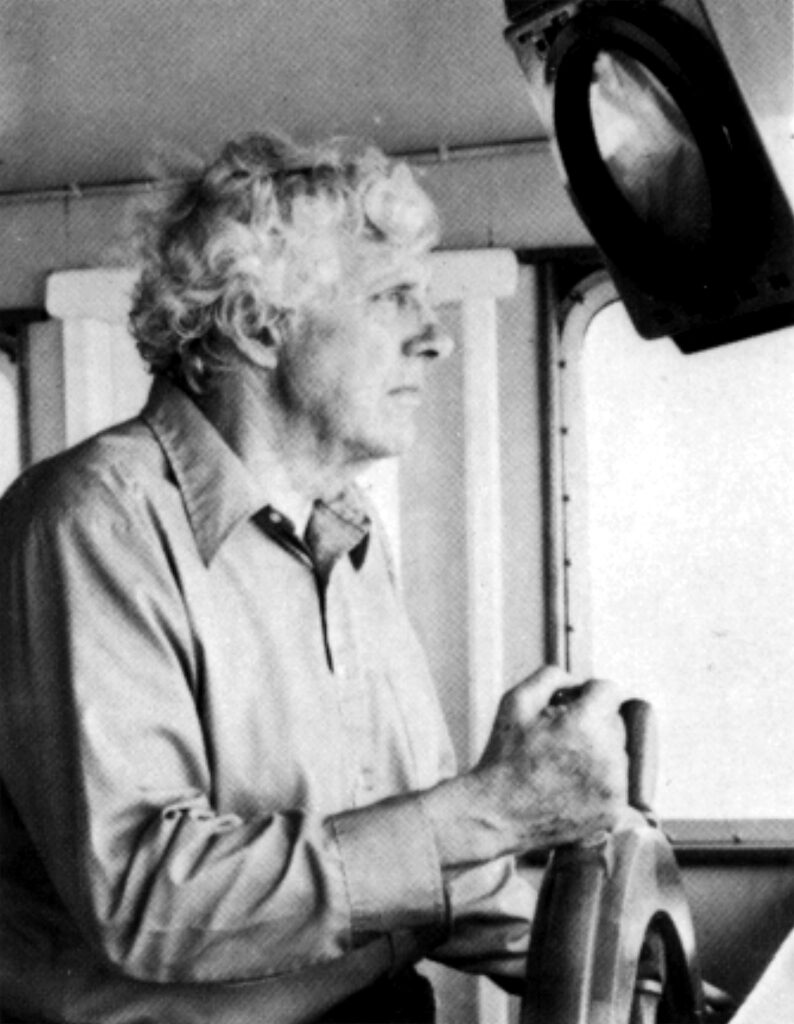
JEREMY
Yeah, and I just want to mention that Edward Rowe Snow was an inspiration to me as a kid, and one of the reasons I got into maritime history in the first place. And as the longtime president of Project Gurnet and Bug Lights, Dolly has been honored recently with a Keeper of the Light award from the American Lighthouse Foundation and also a special award from the Hull Lifesaving Museum in recognition of her years on the board of directors of that organization and her work on behalf of many local charities. I sat down with Dolly after the event in Kingston, Massachusetts, in April. So let’s listen to that interview now.
JEREMY
I am here at the Kingsbury Club in Kingston, Massachusetts, and I am here with my friend, Dolly Bicknell. Well, first of all, let me explain exactly where we are. Again, we’re at the Kingsbury Club where Dolly teaches tennis and we’re actually in the Pilates room and I’ll explain that we’re in the Pilates room not because—I don’t do Pilates, heaven forbid I should do anything that strenuous—but we’re here because it’s the quietest space we could find today. But you might hear a little bit of, possibly a little music, although I think they turned the music down for us. But if you hear a little music or background noise, you know where we are. So we’re in the quietest space we could find for this interview. But that’s where we are today. And thanks so much for joining me today, Dolly, I really appreciate it.
DOLLY BICKNELL
Thank you. It’s a pleasure to be here.
JEREMY
Well, thanks. So, Dolly, you and I have known each other for a while. I think it goes back more than 30 years now since I first interviewed you when I was doing a series of videos about your father, Edward Rowe Snow, the great maritime historian who had such a huge impact on me. But today I’d like to talk a bit about your involvement with Project Gurnet and Bug Lights. So can you tell our listeners a little bit about how you first got involved with that organization?
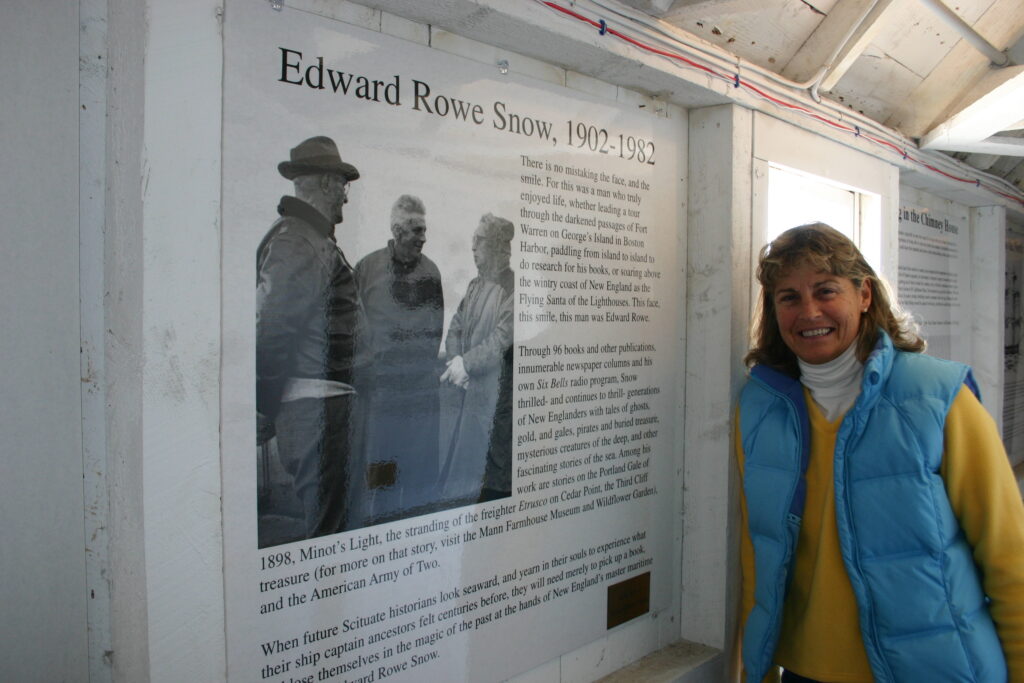
DOLLY BICKNELL
Well, back in 1983 Bug Light was going to be torn down. They were going to put up a fiberglass pole in its place with a light on top of it. And it was a group of people who got together and they formed a group called Save Bug Light, or they said “save bug light,” but they formed a group called Project Bug Light and they saved the lighthouse. They made the Coast Guard understand that there was a group of concerned people, that they could raise money to help take care of it, and that was fine. But as time went on, volunteer interest must have waned because five years later the Coast Guard was again going to replace it with a fiberglass pole. And they were not able—well, the interest was gone. So then, in 1993, Dr. Don Muirhead, who was a pediatrician from Duxbury, came to me and asked if I wanted to go to a meeting. And I said sure, because I love lighthouses.
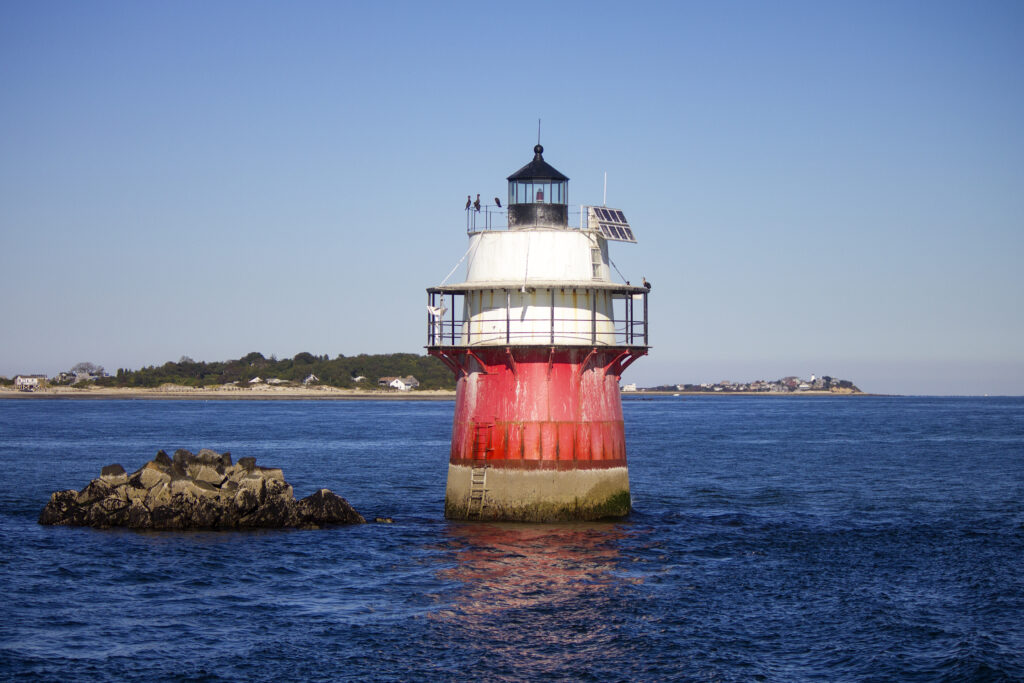
And so he then asked if I would like to be a part of the group and I thought it would be great, because we got to go out to Duxbury Pier or Bug Light and we got to scrape the lighthouse, paint it. We were out there when the foghorn went off once, which was very interesting. But it was a great organization. I had a fun time. As time went on, then we, the group had a chance to acquire another lighthouse, the Gurnet Light, and we changed the name to Project Gurnet and Bug Lights. So I’ve been a part of that group for a long time. In fact, I think it was 1999 when I became president of that group and I’m still president. We’re trying to save the light. And we also, maybe I shouldn’t say this yet, but the Government [sic] Services Administration has given us title to it and we will be, we’ve been taking care of it since 1993 but now we’re really supposed to and we’re able to and we’ll have to take care of it.
JEREMY
Well, that’s pretty exciting. It’s not a secret so—
DOLLY BICKNELL
No, it’s not a secret. We haven’t had our, our ceremony that transfers it yet because we haven’t had time. We’ve been involved with a lot of other ceremonies recently, but it will happen and we’ll have to get back to getting out there.
JEREMY
Now, Duxbury Pier Lighthouse, which again is known in the area as Bug Light, is one of several lighthouses that’s nicknamed bug light, but I think that’s what everybody around here calls it. It was actually the first offshore caisson lighthouse in the United States—
DOLLY BICKNELL
Right!
JEREMY
–when it was built in 1871. That certainly makes it special. What are some of the other reasons? What is special to you about Bug Light and why does it need to be preserved?
DOLLY BICKNELL
Well, we don’t want it torn down and a fiberglass pole put up.
JEREMY
That happened to Deer Island Light in Boston Harbor.
DOLLY BICKNELL
And have you seen what it looks like now?
JEREMY
Now it’s not even a fiberglass tower. Now it’s a little, a nondescript steel thing.
DOLLY BICKNELL
Right. Yeah. There’s a reason that lighthouses are special. And they’re— what did we say in our mission statement? “Unique historic monuments to our nautical past.” And you don’t want those torn down. We’ve been trying to take care of them, and they also are still aids to navigation. People have GPS now, but the Coast Guard will still take care of the aids to navigation. That’s the lantern, the foghorn, and the solar panels that provide the electricity for it. And it’s, it’s a very odd building. They call it — it’s like a spark plug.
JEREMY
Before sparkplugs were around I think it was known as a coffeepot lighthouse.
DOLLY BICKNELL
Right, exactly. And we have old pictures that are really kind of fun of the lighthouse before it had the catwalk, because they, it was, it just went straight up on the sides and they, then they built the catwalk so that keeper would have a place to go. And also it helped for the getting water. The cistern. And that’s another thing to think about where you have a lighthouse that has a roof where the seagulls are, but that’s where you get your drinking water, from the rainwater.
JEREMY
It was an interesting place to live for the keepers, for sure.
DOLLY BICKNELL
It’s funny, one of the lighthouse keepers, actually, we spoke to him. Henry Salter, his name was.
JEREMY
He wrote a booklet about it.
DOLLY BICKNELL
Yes, he did. And he said to me one day, “Do you know why they call it Bug Light?” And I’m going, “Oh good. Finally we’ll know.” You know, sometimes they talk about lobsters being bugs, or it looks like a bug on the horizon. And he said to me, “Because when you were in it, you went buggy.” (Laughs)
JEREMY
That probably makes at least, I don’t know, somewhere between five and 10 different explanations I’ve heard for Bug Light.
DOLLY BICKNELL
It must’ve been odd to be there because it’s circular and there are no corners, and it’s tiny too. I mean it must have been odd because you had people there with you. It must’ve—it’s, well, that’s what lighthouse keepers are all about. They’re a different kind of person that wants to be by themselves.
JEREMY
Yeah. Well I know that one of the early keepers of Minot’s Light quit because he said he couldn’t stand round walls anymore. It definitely took a special kind of person. Now, the public can’t visit Bug Light.
DOLLY BICKNELL
No. In fact, when we were given ownership of it, we promised that we would not take tours there. Right. You can certainly drive by it—not drive by it; you may motor by it or sail by it because it is surrounded entirely by water.
JEREMY
Right. Yeah. Under the National Historic Lighthouse Preservation Act, which is how you got ownership, one of the main goals of that is public access, but then obviously they have to make exceptions with some of these lighthouses.
DOLLY BICKNELL
Exactly. And we promised that we would do education at different places about this. You know, there are tours that go out of the harbor and that go out for whale watches and we will give them information about it so that if the captains feel so inclined, they can give some history as they go by.
JEREMY
That’s great.
MUSICAL INTERLUDE
JEREMY
Well, let’s, let’s move on and talk a bit about Plymouth Lighthouse, also known as Gurnet Light. And again, a lot, so many lighthouses have more than one name, but I think most local people know, know it as the Gurnet, right?
DOLLY BICKNELL
Right. It’s actually part of Plymouth Light Station. And that includes the lighthouse, the keepers’ cottage, and Revolutionary War Fort Andrew.
JEREMY
Yes, it is certainly one of the most historic light stations in the country. I know we could talk for a long time about it, but what, just maybe a couple of points. What is so historic about it?
DOLLY BICKNELL
Well, it’s the oldest freestanding wooden lighthouse in America. The very first female lighthouse keeper was out there.
JEREMY
So I’ve heard.
DOLLY BICKNELL
Yes. That was Hannah Thomas. And she was the keeper when her husband, Major General John Thomas, was in Canada fighting in the Revolutionary War. And then after he passed away, he died of smallpox up there, she continued to be the keeper in his absence. So that’s pretty fun.
JEREMY
Well, those are two big, big, big, big important facts.
DOLLY BICKNELL
Oh. It was twin lights. It was the first twin lights in America.
JEREMY
Now, your group cares for the modern ranch house that was built in the early 1960s for the Coast Guard keepers of the Gurnet. And that’s available as a rental. Is that right?
DOLLY BICKNELL
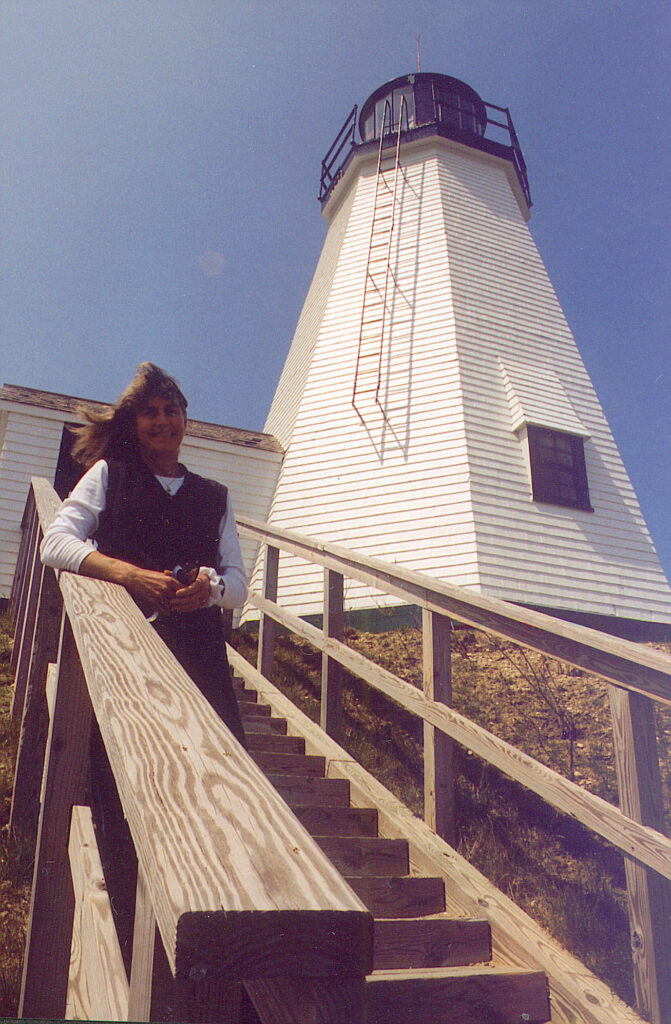
Yes, it is. We now call it the keepers’ cottage and we have it for rent. It actually sleeps 14 people. We have cool bunk beds. With all different— we’ve got one, two, three, four bedrooms, two bathrooms and, it is available for rental but it is pretty much rented. We were given the chance to take care of the keepers’ cottage also after we had been given a license to take care of Plymouth Light. They asked if we’d like a license to take care of the keepers’ cottage, too. Originally we had said no, but then we decided that it would be a good fundraiser, money raiser. So we do have it for rent. It is booked all summer. People who rent it often rent it for many years in a row and that’s the way it is.
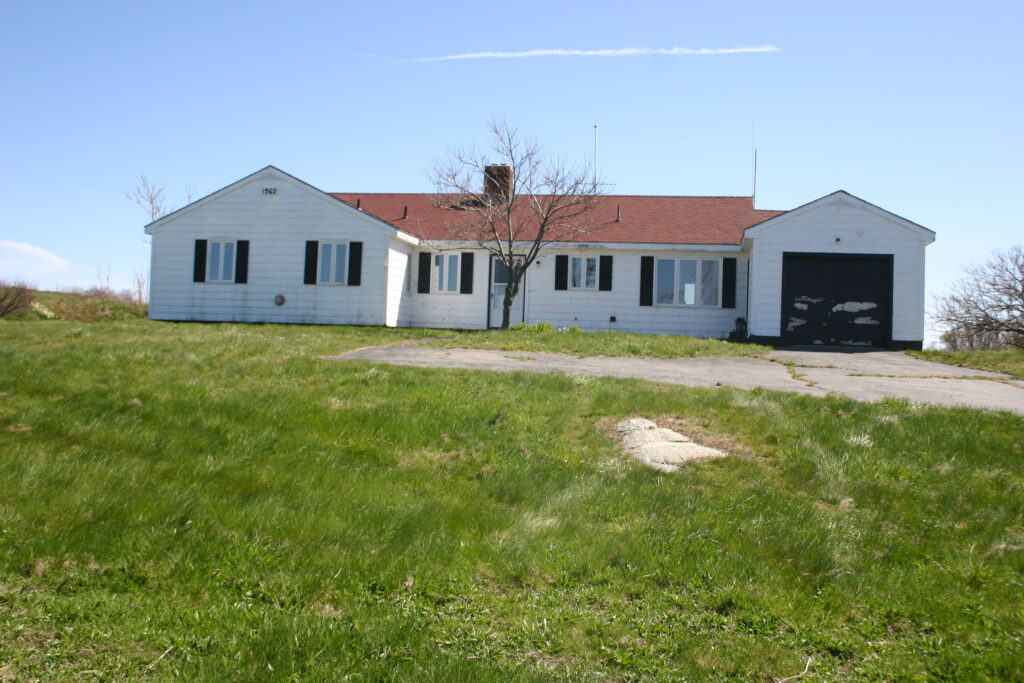
JEREMY
That’s great. So as far as visiting the lighthouse, it’s normally kind of off limits to the public. It’s a private community out there.
DOLLY BICKNELL
It is. They have a guard person at a guard check. You have to say where you’re going or be on the list. Our renters are on the list. We have their names and their guests’ names there. But once you get out to the end, after you’ve gone down the five-mile dirt road, that is not often very smooth—
JEREMY
I’ve driven it, I know.
DOLLY BICKNELL
Yes, then you get there and the guard shack asks you who you are and why you’re there. So most people can’t go there. But on the Saturday of Memorial Day weekend, we have an open house and we shuttle people out, in case you don’t want to drive out on the bumpy road. People can drive out. But we have—it’s so much fun. We have tours. You can go into the keepers’ cottage, you can go to the lighthouse, you can climb the lighthouse, and also climb down the lighthouse, and you get to see Fort Andrew, which is the Revolutionary War fort.
We actually have re-enactment people. We have someone portraying Hannah Thomas, Major General John Thomas, and we have somebody representing the War of 1812 and the Civil War. I think that’s all, right. And Richard Boonisar opens up his lifesaving station to the public and he doesn’t do that very often.
JEREMY
That’s a treat. I’ve been in there.
DOLLY BICKNELL
It is a treat. A wonderful thing. So it’s a lot of fun. We have a lot of people who come out and this year it was May 25th.
JEREMY
Yeah, that’s a great thing. I’ve been out there a couple of times for that.
DOLLY BICKNELL
Sometimes if people would really like tours, we’re working on having this on the website that people can ask for tours and we might be able to arrange that.
JEREMY
Okay. Now, the lighthouse was actually moved back in 1998 about 140 feet back from the edge of the bluff, which is constantly eroding.
DOLLY BICKNELL
Yeah, we’ve had a major problem with that. We’ve lost 28 feet in the last three years. We’ve lost so much, and people go out there and they say, “Oh, there’s a fence that says danger. Let’s get my picture taken on the other side.” So they have idea what the erosion is like. But anyway, back to your question, you talked about it being moved back 140 feet. The lighthouse itself is still far enough away from the cliff. The Coast Guard’s solar panels are much closer. A lot of the fort, which is a berm—it’s earth—but a lot of that may go over soon. We are trying to build a revetment and we’re having trouble getting permitting for it because there’s a lot of work involved in that. And we will probably have to raise about a million dollars to be able to do this, to protect the fort and the lighthouse and that part of Gurnet Point. And that’s going to be a challenge. So if you’ve got a million dollars, feel free.
JEREMY
Yeah. Well I guess the good news out of all that is that if worse comes to worst, the lighthouse itself at least is relatively small and easier to move than some other massive lighthouses.
DOLLY BICKNELL
Yes. I wish I had seen it when that happened, but they did put it on rails, similar to a railroad and were able to move it back pretty far.
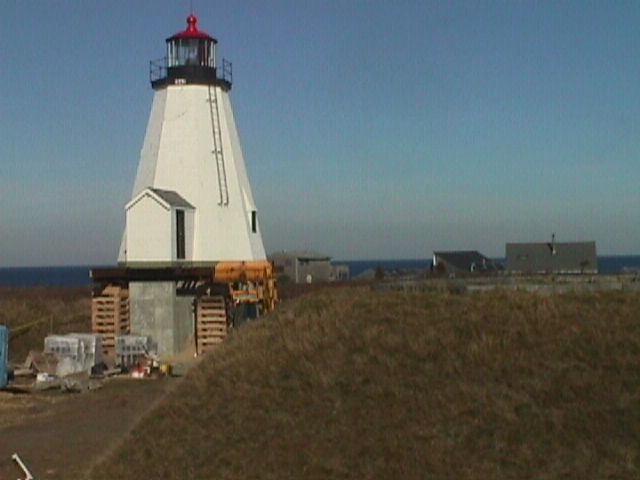
JEREMY
Right. Before we wrap things up today, just a couple more general questions. How did you get involved with lighthouse preservation in the first place?
DOLLY BICKNELL
Well, my father, as you said, was Edward Rowe Snow and he was the Flying Santa. He was very interested in lighthouses. He wrote books about pirates and shipwrecks and buried treasure. And I’ve always been interested in lighthouses. I got to go on the Flying Santa when I was young and that’s when my dad would fly over the lighthouses and drop packages for the lighthouse keepers and their families. And that was pretty special because a lot of them were really isolated. And now, all the lighthouses are automated except for Boston Light, which has a keeper now there are Coast Guardsmen and now the Flying Santa brings presents to the Coast Guard’s people and their children.
JEREMY
Yeah. And we are going to get together again and do a more extensive interview on that very subject.
DOLLY BICKNELL
Really? Okay.
JEREMY
Yeah, I’m not going to let you get away with just that little bit. So we will talk about that again. But I had a feeling that that was going to be along the lines of your answer to that question. So we’ll get back to that. So one more question. Why do you think lighthouses have had such lasting appeal for people, Dolly?
DOLLY BICKNELL
Well, may I quote my father?
JEREMY
I think that would be ideal.
DOLLY BICKNELL
In his first edition book of The Lighthouses of New England, which was published in 1945 he said, “Lighthouses from the earliest times have fascinated and intrigued members of the human race. There is something about a lighted beacon which suggests hope and trust and appeals to the better instincts of all mankind.”
JEREMY
Well, I don’t think it could be said to be better than that, so thank you Dolly. Thanks so much for being with me today and we’re going to do this again real soon and talk about some other aspects of lighthouses.
DOLLY BICKNELL
Thank you so much. Great to see you, Jeremy.
JEREMY
Thank you, Dolly.
MUSICAL INTERLUDE
MICHELLE
If our listeners would like to get more information on Project Gurnet and Bug Lights, they can go to the website at buglight dot org.
JEREMY
Thank you, Michelle. And now it’s time for our segment on lighthouse history. Ta dah! Last week we told you about the great Pharos of Alexandria, which was built near the Harbor of Alexandria in Egypt around 279 BC and is considered the first significant lighthouse in the world. There may have been other simple beacons and various cultures, but some of the other earliest lighthouses were built by the Romans in the English Channel around the first and second centuries, AD.
MICHELLE
One of the lighthouses the Romans built still stands on the grounds of Dover Castle in Kent, where it guided shipping into the ancient Roman port of Dubris. The lighthouse is sometimes referred to as Dubris Pharos. The Romans invaded Britain in 43 AD and what we now know as Dover was chosen as the base for the Classis Britannica, the fleet that patrolled the English Channel and the North Sea. From the castle and lighthouse, you can see all the way to the French coast across the Strait of Dover on a clear day, about 23 miles away.
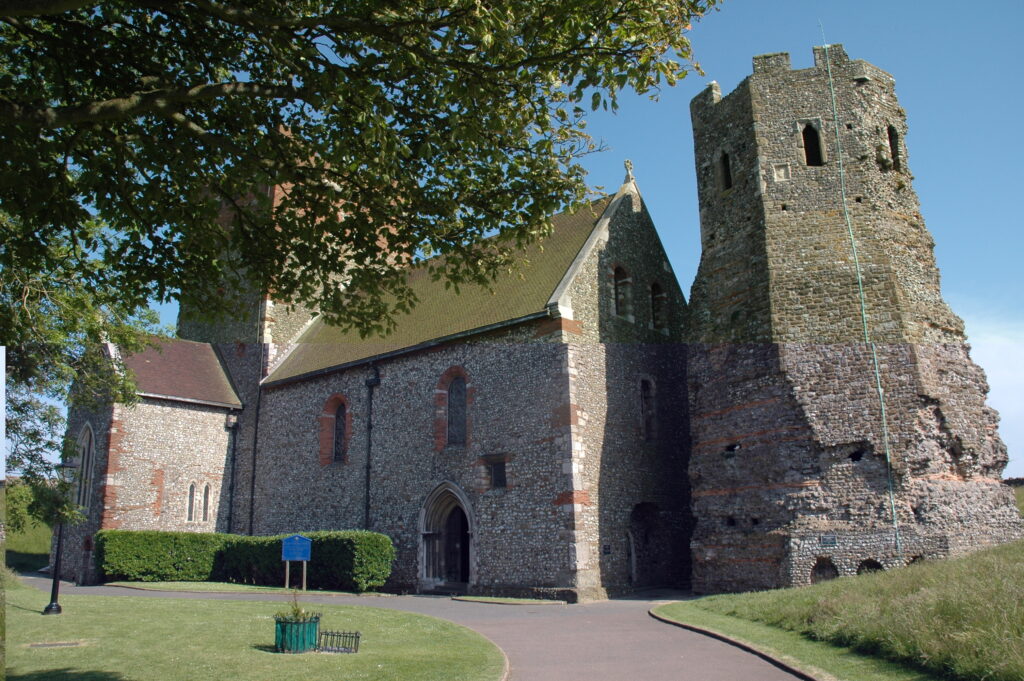
JEREMY
The Roman lighthouse at Dover is considered the oldest building in England and is the oldest standing lighthouse in the world. There’s some debate over exactly when it was built, but it was probably sometime in the first century AD. It’s also the tallest surviving Roman structure in Britain. It’s about 52 feet tall, but it’s believed it was quite a bit taller when it was first built.
MICHELLE
Parts of the lighthouse have been reconstructed over the years. The lighthouse stands alongside the reconstructed church of St. Mary-in-Castro, and it probably owes its survival to the fact that it was used for some time as a bell tower for the church. Old illustrations show the lighthouse and church connected by a covered passageway.
JEREMY
The Roman lighthouse stands on the eastern heights of Dover. A twin lighthouse once stood on the western heights. There are two other lighthouses that survive from the former Roman Empire. The others are at Leptis Magna in Libya and La Coruña in Spain.
MICHELLE
There’s not much left of the Roman lighthouse at Leptis Magna, which is 78 miles east of Libya’s capitol, Tripoli, on an old Roman coastal road running from Alexandria to Carthage. Leptis Magna was a prominent port on the Mediterranean of the Carthaginian Empire and Roman Libya, and the ruins of the city are considered some of the best preserved Roman ruins in the world.

JEREMY
The lighthouse at Leptis Magna, which was built in the third century AD, originally stood more than 100 feet tall. There’s not much of it left, but it qualifies the second most substantial ancient lighthouse ruins in the world after the Roman lighthouse at Dover. We’ll take a look at the lighthouse at La Coruña in Spain in the next installment of Light Hearted.
MUSICAL INTERLUDE
JEREMY
Very special thanks to the staff of the Portsmouth Public Library in beautiful and historic Portsmouth, New Hampshire, where we’ve been recording today. Thank you to Jeff Gales, Maria Guevara, Tom Wheeler, Tom Tag, and all the other staff and volunteers of the U.S. Lighthouse Society. For more information on how you can become a member of the USLHS and for information on their domestic and international tours, check out USLHS.org. A special shout out to all the members of the Friends of New England Lighthouses Facebook group, all 14,000 of them. And Michelle, I think you are a member of that group. Of course you’re a member of that group. You have been for quite a while. I know you have.
I want to invite our listeners to come visit Portsmouth Harbor Lighthouse in New Castle, New Hampshire, just down the road from here during our weekly Sunday afternoon open houses. Michelle, you’re pretty much always there on Sunday afternoons.
MICHELLE
I’m pretty much a regular.
JEREMY
Were you there at every open house last season?
MICHELLE
There was one that I missed last year but that was it.
JEREMY
Due to one of your injuries, I think.
MICHELLE
Yeah.
JEREMY
But we won’t talk about that. And my other frequent cohost Cindy Johnson is the operations manager. She’s pretty much always there and I’m usually there. You can get more information on the website for Friends of Portsmouth Harbor Lighthouses, which is a chapter of the American Lighthouse Foundation. The website is portsmouthharborlighthouse.org. And of course, special thanks to my cohost today, Michelle Jewell Shaw. Michelle, anything else you’d like to add?
MICHELLE
I would just like to thank you again, Jeremy, for having me on here with you today, and I’d also like to thank you all for listening to us and look forward to seeing you at open houses.
JEREMY
That wraps it up for this edition of Light Hearted. Until next time, keep a good light.
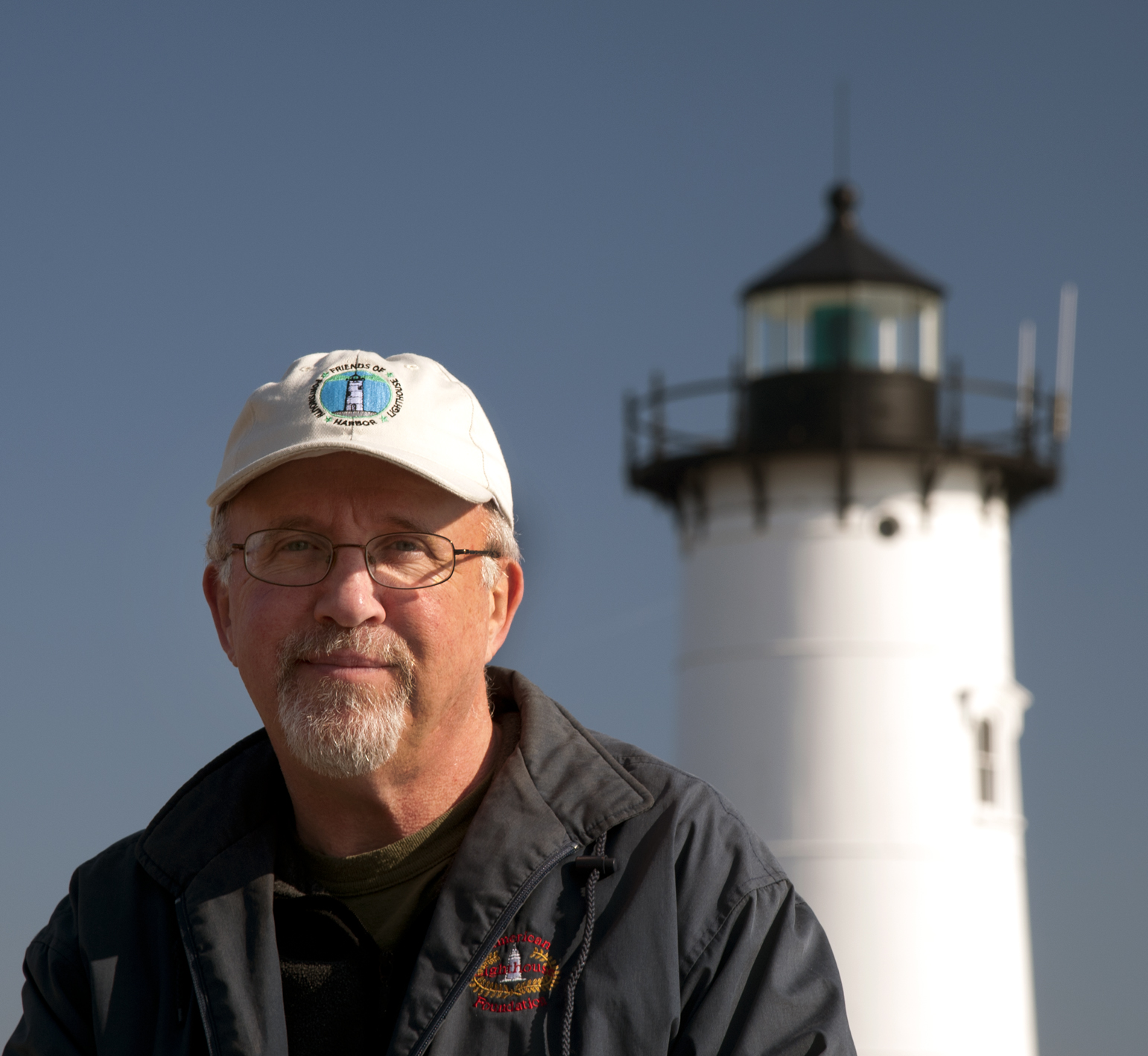
Jeremy D’Entremont is the author of more than 20 books and hundreds of articles on lighthouses and maritime history. He is the president and historian for the American Lighthouse Foundation and founder of Friends of Portsmouth Harbor Lighthouses, and he has lectured and narrated cruises throughout the Northeast and in other regions. He is also the producer and host of the U.S. Lighthouse Society podcast, “Light Hearted.” He can be emailed at Jeremy@uslhs.org

